Global migration to IP-based voice is accelerating faster than most enterprises anticipated, by 2027, over 90% of business voice traffic will move off legacy PSTN networks. With national phaseouts scheduled across the UK, EU, and parts of Asia, IT leaders are under pressure to modernize telephony infrastructure without losing reliability or control.
Yet one question keeps surfacing in every migration plan: Do we need SIP trunking, an SBC, or both?
The confusion is understandable. SIP trunking and Session Border Controllers (SBCs) are often discussed together, but they serve entirely different roles. SIP trunks provide the connectivity, linking enterprise PBX systems to global voice networks over IP. SBCs, meanwhile, provide the control layer, securing, normalizing, and managing those SIP sessions to prevent fraud, ensure compliance, and maintain call quality.
Treating them as competitors leads to costly architecture mistakes. SIP trunks without SBCs invite exposure to toll fraud and service disruptions; SBCs without SIP trunks offer no external connectivity at all. Understanding how they complement each other is essential for building a voice infrastructure that’s both scalable and secure.
In the following sections, we’ll break down the functional differences between SIP trunking and SBCs, show how they work together in modern VoIP ecosystems, and outline best practices for designing a hybrid SIP + SBC deployment that’s future-proof and regulation-ready.
The Real Question — SIP or SBC, or Both?
Most IT managers approach “SIP trunking vs SBC” searches expecting a verdict, which one to choose. But that’s the wrong question. SIP trunking and Session Border Controllers (SBCs) aren’t rivals; they’re interdependent layers of a modern VoIP architecture. One connects your enterprise to the outside world, while the other protects and regulates that connection.
With PSTN networks scheduled for shutdown across the UK by 2027 and the EU by 2030, every business still relying on ISDN or PRI lines will need a digital alternative. SIP trunking is that alternative — carrying voice as IP packets through the internet instead of copper lines. According to IDC, global VoIP traffic continues to grow at a 17% CAGR, driven by remote work and unified communications adoption.
Think of SIP as the carrier path, it moves calls between your PBX and the world. The SBC, on the other hand, acts as the control layer, inspecting, securing, and optimizing every session that travels across that path. Without SIP, your system can’t connect; without an SBC, it can’t defend or stabilize that connection.
In the next sections, we’ll unpack how each component works:
- The architecture behind SIP trunking and its replacement of legacy PRI lines.
- The security and interoperability challenges SIP faces without SBC mediation.
- And the selection criteria for building a SIP + SBC setup that scales safely across regions and providers.
SIP Trunking — The Service Backbone of Modern Telephony
SIP trunking is more than a cost-cutting upgrade, it’s the underlying transport that lets businesses communicate natively over IP. It transforms analog voice into digital packets, routes them across secure internet connections, and integrates directly with on-prem or cloud PBX systems.
How SIP Trunks Replace Legacy PRI
In legacy setups, each voice channel required a dedicated physical line. SIP trunking removes that dependency by virtualizing channels over a single broadband or MPLS connection.
Diagram suggestion: PSTN → SIP Trunk → PBX
Here’s how it works: when a user places a call, the PBX converts the analog signal into digital form. The data is then encapsulated in SIP packets and routed through an Internet Telephony Service Provider (ITSP). This approach allows the same IP infrastructure that carries email and applications to also handle voice traffic securely and efficiently.
Providers like DIDlogic extend this logic globally, offering direct routing across multiple regions, with coverage that spans local, toll-free, and mobile number ranges. This makes SIP trunking an ideal foundation for multinational enterprises needing local presence in dozens of countries without maintaining physical lines.
Core Operational Benefits (with Data)
SIP trunks typically cost 40–60% less than traditional PRI circuits (source: TechTarget, IDC). Beyond direct savings, they introduce flexibility legacy systems can’t match:
- Instant scalability: Businesses can scale from five to fifty concurrent channels within minutes, without hardware changes.
- Number portability: Keep existing phone numbers during migration, avoiding customer confusion or reprinting costs.
- Global reach: Deploy local numbers in different countries while managing all traffic from a single centralized system.
For instance, a multinational retailer using DIDlogic’s SIP infrastructure expanded from one regional office to 12 locations across Europe — adding over 200 concurrent channels — all through a software-based configuration, without additional wiring or local carriers.
SIP’s Limitations Without SBC
Despite its flexibility, SIP trunking alone doesn’t guarantee reliability. Without an SBC, networks are vulnerable to SIP spoofing, malformed packet floods, and toll fraud, which collectively cost businesses billions annually. Even when secure, SIP can encounter NAT traversal and codec mismatch issues that degrade call quality or cause dropped sessions.
These weaknesses expose the need for an intelligent control layer, the Session Border Controller, to normalize signaling, encrypt traffic, and enforce Quality of Service (QoS) across complex multi-site networks. It’s the missing safeguard that turns SIP from a transport method into a robust enterprise-grade communication backbone.
Session Border Controller — The Gatekeeper of VoIP Integrity
If SIP trunking is the backbone of modern telephony, the Session Border Controller (SBC) is its immune system, inspecting, filtering, and shaping every packet that enters or leaves the network. SBCs act as policy enforcement engines, sitting between your internal PBX or UCaaS platform and external carriers. Their job isn’t just to block threats but to manage every SIP session according to business rules, compliance requirements, and performance thresholds.
In enterprise networks, thousands of simultaneous voice sessions cross multiple borders: corporate firewalls, cloud platforms, and carrier interconnects. Each boundary introduces risks — codec mismatches, signaling variations, or route failures. The SBC resolves those inconsistencies in real time, ensuring secure, consistent, and high-quality communication flow.
Core Responsibilities
An SBC’s role extends far beyond security. It performs continuous mediation and optimization across several key dimensions:
- SIP normalization: Aligns signaling formats between incompatible systems (e.g., Microsoft Teams and Cisco CUCM) to ensure calls connect seamlessly.
- Topology hiding: Masks the internal IP structure of an enterprise, preventing attackers or carriers from mapping network layouts.
- Encryption and media anchoring: Protects signaling and RTP streams using TLS and SRTP, anchoring media through the SBC to maintain quality even across NATs.
- Call Admission Control (CAC): Regulates concurrent sessions based on bandwidth availability, ensuring that network congestion never degrades call quality.
- QoS enforcement: Monitors packet loss, latency, and jitter, applying traffic shaping to maintain a consistent Mean Opinion Score (MOS) above 4.0.
Example:
During a provider outage, an SBC can automatically reroute all outbound calls to a backup SIP trunk or regional gateway. The switch happens in milliseconds, keeping operations running without users even noticing — a level of continuity no single PBX or trunk can achieve alone.
Deployment Models
SBCs come in three main forms, each tailored to different infrastructure and control requirements:
- Hardware SBCs
- Purpose-built appliances offering maximum stability and throughput.
- Ideal for large enterprises with strict regulatory or latency demands.
- Downsides: high upfront cost and limited flexibility for remote scaling.
- Purpose-built appliances offering maximum stability and throughput.
- Virtualized SBCs
- Software-based, running on VMware, Hyper-V, or similar environments.
- Easier to integrate with existing data center infrastructure.
- Offer better scalability but rely on underlying server performance.
- Software-based, running on VMware, Hyper-V, or similar environments.
- Cloud SBCs
- Fully managed and elastic, hosted by service providers or public cloud platforms.
- Simplify multi-region voice deployments and disaster recovery.
- Depend on internet reliability and vendor uptime.
- Fully managed and elastic, hosted by service providers or public cloud platforms.
Many ITSPs, including DIDlogic, integrate SBC functionality directly at the network edge, offering customers built-in policy control and session security without requiring dedicated hardware. This hybrid model merges flexibility with expert-level management, reducing operational overhead for enterprises that don’t need to maintain in-house SBC expertise.
| Feature | Managed SBC (via ITSP like DIDlogic) | On-Prem SBC |
| Setup & Maintenance | Fully managed by provider; zero local upkeep | Requires in-house installation and ongoing patching |
| Scalability | Instantly scalable across global regions | Limited to on-site capacity |
| Security & Updates | Provider handles firmware, TLS, and SRTP updates | Enterprise must manage all updates manually |
| Control & Customization | Policy rules configured via admin portal or API | Full control over routing, policies, and integrations |
| Cost Model | Subscription or per-session billing | Capital expense + annual maintenance |
| Ideal For | Distributed or multi-location businesses | Enterprises with dedicated telecom teams |
SIP vs SBC — Understanding Their Relationship
SIP trunking and Session Border Controllers often appear in the same sentence, yet their functions operate on entirely different layers. SIP handles connectivity, while SBCs handle control. The relationship isn’t competitive — it’s structural. Together, they form the foundation of every modern VoIP deployment that aims to balance scalability, reliability, and security.
Layer Logic
At its core, SIP trunking provides transport and session signaling, it’s the pathway through which voice traffic travels. SIP trunks connect a business’s PBX or UCaaS system to the outside world, replacing traditional phone lines with IP-based communication.
An SBC, on the other hand, governs the border where networks meet. It performs border mediation, policy control, and security enforcement, ensuring that every SIP session entering or leaving the enterprise adheres to defined standards and remains secure.
Think of it this way:
SIP is the highway, moving packets between destinations.
The SBC is the toll booth, inspecting traffic, authenticating vehicles, and ensuring only legitimate, well-formed sessions pass through.
Without SIP, there’s no connection; without an SBC, there’s no control. Both are indispensable when building voice infrastructures that span multiple providers, regions, and regulatory frameworks.
Functional Intersection
SIP trunking and SBCs overlap at one critical point, interoperability. Every carrier, PBX, and UCaaS platform speaks its own dialect of SIP, with subtle signaling and codec differences that can break communication if left unmanaged. SBCs solve this by normalizing signaling between systems like Microsoft Teams, Cisco CUCM, and Asterisk, allowing them to coexist under a unified voice framework.
It’s technically possible to run SIP trunks without an SBC, and some small businesses do, especially when their provider hosts a managed SBC layer. However, in enterprise-scale environments, this approach quickly breaks down. Compliance requirements (HIPAA, PCI-DSS, GDPR), advanced routing needs, and cross-carrier interoperability demand an SBC to maintain security, quality, and regulatory integrity.
For large networks handling thousands of concurrent sessions, the SIP–SBC partnership isn’t optional, it’s architectural necessity. The SIP trunk delivers reach; the SBC guarantees that reach stays protected, optimized, and compliant.
Why Enterprises Pair SIP Trunks with SBCs
Enterprises don’t combine SIP trunking and Session Border Controllers out of habit, they do it because the pairing directly protects revenue, compliance, and uptime. While SIP trunks provide the global reach, SBCs safeguard that connectivity under real-world conditions. The result is a resilient, regulation-ready, and performance-driven telephony network. Below are three measurable reasons why this combination has become the default standard for large-scale voice deployments.
Security
Telecom fraud remains one of the most expensive and persistent threats in enterprise communications. According to the Communications Fraud Control Association (CFCA, 2024), global toll-fraud losses exceeded $40 billion last year alone. Attackers often exploit open SIP ports, sending INVITE floods or malformed RTP streams that trigger unauthorized calls and rack up international charges within minutes.
SBCs act as real-time gatekeepers, inspecting every SIP packet before it reaches the PBX or UCaaS layer. They block suspicious INVITEs, enforce IP whitelisting, and detect denial-of-service patterns early. Topology hiding further prevents intruders from discovering internal network addresses — a simple but crucial layer of defense that standard firewalls rarely provide.
For enterprises operating across multiple countries and carriers, SBC-based traffic policing can be the difference between a secure network and a multimillion-dollar breach.
Compliance & Interoperability
Regulated industries such as healthcare, finance, and e-commerce can’t risk unmonitored SIP traffic. Voice data often contains personal information and payment details, meaning that PCI-DSS, HIPAA, and GDPR all treat VoIP calls as sensitive transmissions. SBCs enforce encryption (TLS/SRTP), call logging, and routing policies that keep enterprises within these frameworks.
Beyond compliance, SBCs also serve as translators between mismatched systems. A single enterprise might use Microsoft Teams, Cisco CUCM, and Asterisk instances across different regions. Each platform uses slightly different SIP signaling and codecs. The SBC bridges these gaps automatically, ensuring seamless communication without manual reconfiguration or vendor-specific add-ons.
This interoperability saves hours of engineering time and avoids downtime when new carriers or UCaaS integrations come online, a practical compliance and efficiency gain in one move.
QoS and Business Continuity
Quality of Service (QoS) directly shapes how customers perceive a company’s reliability. An SBC enforces traffic priorities across voice and data channels, ensuring Mean Opinion Scores (MOS) above 4.0 even during network congestion. By anchoring and shaping RTP streams, it guarantees consistent audio quality across offices, regions, and devices.
High-availability configurations add another layer of resilience. Enterprises often deploy dual SBCs across two data centers or cloud regions. When one path experiences latency spikes or fails altogether, the secondary SBC instantly takes over, preserving active calls and preventing service interruption.
In measurable terms, enterprises implementing redundant SBCs report 99.999% uptime, translating to fewer than five minutes of voice downtime per year, an operational target nearly impossible to achieve with SIP trunks alone.
When You Might Not Need a Dedicated SBC
Not every business needs to deploy or maintain its own Session Border Controller. For small and mid-sized businesses (SMBs) or startups, building an in-house SBC layer can add unnecessary cost and complexity. In many cases, the right service provider already integrates SBC functionality into their infrastructure, delivering enterprise-grade protection without additional hardware or configuration.
If your organization uses a cloud PBX or a provider-managed SIP trunking service, such as DIDlogic’s hosted SBC layer, session control and policy enforcement are handled directly within the carrier network. That means SIP normalization, encryption, and topology hiding are already active, invisible to the user but critical for secure operation.
Similarly, cloud UCaaS solutions like Zoom Phone, RingCentral, or 8×8 include built-in SBC logic as part of their edge network. They manage signaling, codec translation, and QoS policies centrally, which simplifies deployment and eliminates the need for local SBCs.
Even in these scenarios, however, understanding how SBCs function remains vital. Knowing what protections and controls a vendor provides helps during vendor vetting and SLA evaluation. Enterprises that understand SBC roles can ask the right questions:
- Does the provider enforce TLS/SRTP encryption?
- How are concurrent sessions controlled during spikes?
- What redundancy mechanisms exist at the network edge?
In other words, you may not host your own SBC, but you should always know who’s hosting it for you.
Architecting a SIP + SBC Deployment (Step-by-Step Guide)
For enterprises managing their own infrastructure or hybrid environments, designing an effective SIP + SBC architecture requires a structured rollout. The process ensures both performance and reliability from day one.
Step 1 — Assess Network Readiness
Before introducing SIP trunks or SBCs, conduct a network readiness audit. Stable VoIP requires consistent performance across several parameters:
- Bandwidth: Sufficient capacity for concurrent voice sessions (typically 100 Kbps per call).
- Latency: Maintain end-to-end delay below 150 ms.
- Jitter: Keep variation under 30 ms to prevent audio distortion.
- QoS Tagging: Prioritize SIP and RTP traffic using DSCP or VLAN tagging.
Assess existing firewall and NAT configurations as well. Many consumer-grade firewalls block SIP signaling by default or mishandle NAT traversal, leading to one-way audio or dropped calls. Ensuring compatibility here prevents troubleshooting headaches later.
Step 2 — Decide on SBC Placement
SBC placement determines both security exposure and call quality. In most cases, SBCs sit at the edge of the enterprise network, mediating between internal PBX systems and external SIP trunks. This location provides visibility into both sides of the communication flow.
For larger organizations, hosting SBCs in a data center can centralize control and simplify management across multiple sites. If your infrastructure already uses DMZ segmentation, place the SBC within the DMZ to isolate SIP traffic from the internal LAN while still maintaining controlled access.
Cloud-first enterprises often choose cloud-native SBCs, which integrate with virtualized network edges or public cloud environments (AWS, Azure). These deployments provide elasticity and geographic redundancy without hardware maintenance, making them ideal for global VoIP rollouts.
Step 3 — Test and Monitor
Once the architecture is deployed, continuous validation keeps the system healthy. Use SIP trace tools and packet analyzers to verify signaling integrity, latency, and call routing paths. Regularly measure Mean Opinion Score (MOS) and packet loss to ensure audio remains within acceptable thresholds.
Set up redundancy failover testing, simulate provider outages and confirm that secondary trunks or SBCs activate automatically.
For diagnostics, open-source tools like sngrep (for SIP session analysis) and Wireshark (for RTP stream inspection) are invaluable. They help pinpoint codec mismatches, NAT issues, or QoS violations before they affect production traffic.
Effective monitoring turns a SIP + SBC deployment from a static setup into a self-correcting system, capable of adapting dynamically to network fluctuations or carrier changes.
Cost & ROI Perspective
Deploying an SBC is often viewed as a technical decision, but the financial logic behind it is equally strong. A properly implemented SBC doesn’t just secure voice traffic, it directly reduces operational losses and downtime, delivering measurable ROI within months.
Typical SBC licensing costs range from $500 to $5,000 per concurrent session, depending on capacity, encryption requirements, and vendor support. For many enterprises, that cost quickly offsets itself once the SBC begins blocking toll fraud attempts, rerouting calls during carrier outages, and maintaining compliance across regions.
When comparing managed SBC solutions versus on-premise models, the total cost of ownership (TCO) shifts significantly:
| Factor | Managed SBC | On-Prem SBC |
| Initial Cost | None (subscription-based) | High upfront licensing + hardware |
| Maintenance | Provider-managed updates | Internal IT resources required |
| Scalability | Elastic; scales on demand | Requires additional hardware |
| Control | Centralized via portal/API | Full internal control |
| Support | 24/7 provider NOC | Dependent on internal staff availability |
ROI Example:
An enterprise handling 10,000 monthly international calls implemented a managed SBC solution after repeated toll fraud incidents. The SBC immediately prevented unauthorized INVITE floods and reduced downtime by 80%. Within three months, savings from prevented fraud and fewer service interruptions had already exceeded the deployment cost — a clear demonstration of how voice security pays for itself.
How DIDlogic Simplifies SIP + SBC Integration
DIDlogic removes the complexity from deploying and managing SIP and SBC infrastructure by embedding both within its global carrier-grade backbone. Every DIDlogic SIP trunk includes SBC-level routing and session control, ensuring that enterprises receive enterprise-grade protection and call quality without needing to maintain their own equipment.
Because DIDlogic operates points of presence (PoPs) across major telecom hubs worldwide, customers benefit from minimal latency, high availability, and consistent interoperability across multiple UCaaS and PBX platforms. Each connection is tested for codec compatibility, signaling consistency, and encryption stability, ensuring calls route seamlessly regardless of carrier or endpoint.
Transparent pricing underpins the model, no hidden setup or channel fees, only clear per-session or per-minute rates. Enterprises also gain direct access to DIDlogic’s Network Operations Center (NOC) for real-time monitoring, SIP trace analysis, and troubleshooting across global deployments.
FAQs
Can SIP work without an SBC?
Yes, but only in small-scale or cloud-managed environments. Enterprises typically require SBCs to manage interoperability, compliance, and security at scale.
Are cloud SBCs as secure as on-prem ones?
Yes — provided they use TLS/SRTP encryption and operate under certified cloud environments with continuous patching and redundancy.
How does an SBC improve call quality?
By enforcing traffic prioritization and monitoring packet loss, an SBC maintains consistent MOS scores above 4.0, even under heavy network load.
Can one SBC handle multiple SIP providers?
Absolutely. SBCs are designed to route and normalize sessions across multiple carriers, providing failover and load balancing.
What’s the difference between SBC and a firewall?
A firewall filters traffic based on IP and port, while an SBC inspects and manages SIP and RTP packets — controlling signaling, encryption, and media quality at the application layer.
Does DIDlogic offer managed SBC services?
Yes. DIDlogic’s SIP trunking platform includes managed SBC functionality at the network edge, with built-in security, redundancy, and policy enforcement.
Conclusion — Building Resilient, IP-Native Voice Infrastructure
The migration from legacy PSTN to VoIP isn’t a matter of if, but when. As carriers across Europe, North America, and Asia move toward PSTN phase-out deadlines by 2027–2030, businesses must transition to IP-based systems that can handle modern communication demands.
SIP trunking provides the connectivity layer, the digital highway connecting enterprises to the global voice network. Session Border Controllers deliver the control layer, securing, managing, and optimizing every session that travels across that highway. Together, they form the foundation of resilient, compliant, and future-proof communication infrastructure.
Organizations that prepare now won’t just replace old circuits; they’ll gain a scalable platform for global collaboration, cloud integration, and cost efficiency.
Further Reading
- What is SIP trunking?
- SIP trunking capacity
- SIP trunking security
- Differences between SIP trunking and cloud PBX
- Differences between SIP trunking and telephony
- Differences between SIP trunking and IP trunking
- SIP session vs SIP trunk
- SIP Trunking vs PSTN
- SIP Trunking vs H.323
- Advantages of SIP Trunking
- SIP Trunk Costs
- SIP Trunking Migration Plan
- SIP Trunking Requirements










